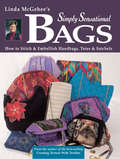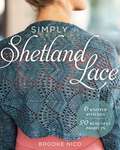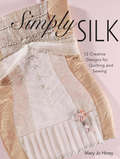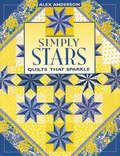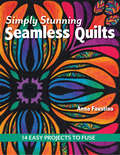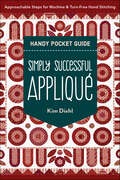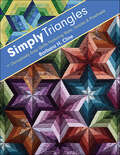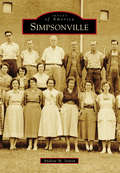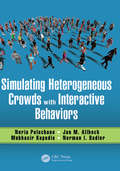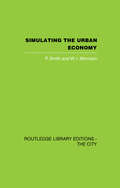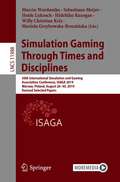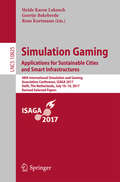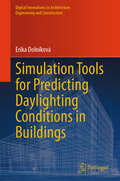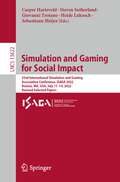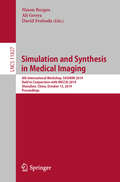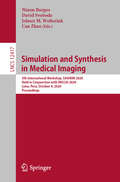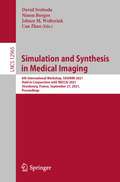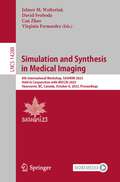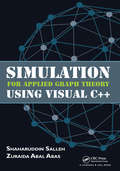- Table View
- List View
Simply Retro with Camille Roskelle: Fresh Quilts from Classic Blocks
by Camille RoskelleyCraft a modern take on classic-block quilt designs with these 12 fun and easy quilting projects.Camille Roskelley, best-selling author of Simplify with Camille Roskelley, puts a brand-new spin on traditional-block quilting. By exploring modern print combinations and employing innovative techniques such as supersizing blocks, Roskelley offers a fresh interpretation of classic blocks in 12 achievable projects. Simple enough for beginners, all the projects are easy to piece using precuts, yardage, and scrap fabrics. And, as always, Roskelley's fail-proof instructions and expert knowledge will guide and inspire every step of the way.Master a variety of simple techniques such as half-square triangles and easy Flying Geese for a bold, sophisticated styleClassic-block quilting gets a modern makeover with jumbo sizes, fresh prints and colors, and secondary patterns created with color placementBridge the traditional and modern with quilts that have timeless appeal
Simply Sensational Bags: How to Stitch & Embellish Handbags, Totes & Satchels
by Linda McgeheeCreate Fabulous Bags with Simple Techniques Distinctive handbags and totes have long been a passion of renowned designer Linda McGehee. In Simple Sensational Bags, Linda shares her secrets for making and embellishing dozens of innovative new designs without spending hours at the sewing machine. Linda's cleverly embellished creations incorporate many popular techniques including decorative stitching, piecing, applique and trims, pockets, piping, and more. With her easy, friendly style, Linda teaches the basics of bag construction, straps, pockets, and decorative embellishment. The book showcases dozens of extraordinary bags. Projects include a zipper cosmetic bag, lingerie and sweater bag, shoe tote, and a variety of handbags. Simple techniques to transform plain bags into spectacular works of art Easy-to-follow instructions for making and decorating bags Detailed discussions of straps, pockets, and finishing touches
Simply Shetland Lace: 6 Knitted Stitches, 20 Beautiful Projects
by Brooke NicoLearn how to master three classic Shetland lace motifs—just six simple stitches—and build your skills with 20 beautiful and varied projects, too! Explore traditional Shetland lace knitting with expert teacher Brooke Nico! She shows how just three simple motifs—Feather and Fan and Old Shale; Acre and Razor; and Horseshoe and Leaf—can yield a variety of lovely items, from fashion, to accessories, to home décor. Step-by-step photos and easy-to-follow instructions help even beginners grasp each stitch, and the projects grow progressively more difficult as knitters become more comfortable with the techniques.
Simply Silk: 12 Creative Designs for Quilting and Sewing
by Mary Jo HineyThis book uncovers the mystery of silk, and demonstrates techniques for bringing out its cooperative nature, and offers inspirational poetry, prose and spiritual expressions. As silk rapidly gains ground as a creative fabric choice. Simply Silk provides a unique approach to transforming this delicate fabric into an easy-to-use material. In addition, this innovative guide also teaches you how to use fabric transfer, machine-stitched wording, rubber stamps and other techniques to create 20+ projects including slippers, chair covers and picture frames.
Simply Stars: Quilts That Sparkle
by Alex AndersonLearn to make stunning star quilts using squares, rectangles, triangles, and diamonds with this comprehensive guide by the host of The Quilt Show.In Simply Stars, Alex Anderson introduces quilters of all skill levels to the world of star quilts, where pattern possibilities are as vast as the night sky. Alex covers the major types of star patterns, such as Stars Made of Squares and Triangles and Stars Made of Diamonds and Y Seams. Covering them in order of difficulty from beginner to advances, Alex offers several examples of each type. With foolproof techniques, Alex’s student-tested shortcuts, and exciting fabric combinations, you can start making quilts that sparkle.
Simply Stunning Seamless Quilts: 14 Easy Projects to Fuse
by Anna FaustinoThe art quilter and author of Simply Stunning Woven Quilts returns with 14 new wallhanging projects using her exciting and original Outline Design style.Textile artist Anna Faustino never stops experimenting with the creative possibilities of quilting. In Simply Stunning Seamless Quilts, she shares her latest methods using fusible appliqué. With Anna’s step-by-step instructions, you'll gain confidence with a craft knife as you learn a variety of raw-edge finishing techniques. An inspirational gallery of Anna’s work accompanies the 14 projects with easily scalable patterns and tips for designing your own illuminated quilts. Surprisingly simple, Anna's techniques promise stunning results!
Simply Stunning Woven Quilts: 11 Easy Techniques, Great Results
by Anna FaustinoCut, weave, fuse & quilt! A guide to the weaving techniques that will take your art quilts to a whole new level. &“Wow! How did you do that?&” No one will believe how easy it is to make these astonishing quilts. The magic is in the weaving techniques that look difficult but are actually simple to master. Learn to weave straight and curved checkerboards, circles, semicircles, or use weaving to rebuild favorite blocks like Log Cabin—then embellish to create a work of art that amazes everyone. Create dazzling quilts with precut fabric strips and eleven amazingly easy weaving techniques No seams, no corners or points to match! Simple construction methods use easy fusible applique and &“stitching-in-the-ditch&” Learn the basics of fabric weaving in three step-by-step lessons, then move on to eight more techniques for weaving and combining fabrics Full-size patterns for circle weaving technique and cutting diagrams for twenty-six different quilts
Simply Successful Appliqué Handy Pocket Guide: Approachable Steps for Machine & Turn-Free Hand Stitching
by Kim DiehlMachine and hand-appliqué essentials at your fingertips! This convenient pocket guide features Kim Diehl's unique and wonderfully successful technique for invisible appliqué by machine and turn-free appliqué by hand. Discover how to shorten your stitching time, how to finish appliqués that aren't reversed from the original pattern, and how preparation can eliminate the need to anchor seam allowances in place with starch or a fabric glue stick prior to stitching. Learn about Kim’s invisible machine-appliqué techniques that use freezer paper and are infinitely quicker to complete. As a bonus, learn how to machine appliqué with trapunto! Best-selling author Kim Diehl of the popular Simple series returns with a convenient pocket guide to machine and hand appliqué. Appliqué confidently with easy-to-follow techniques, clear how-to photos, and tried-and-true tips. Gain the basic skills and knowledge of appliqué for personalized crafts.
Simply Successful Appliqué: Foolproof Techniques For Hand & Machine
by Jeanne SullivanJust 15 minutes to perfection! Learn new appliqué skills and get pinpoint accuracy more easily than ever before in this comprehensive visual guide with a bonus CD of full-size template patterns. Anyone can learn Jeanne's stress-free process and use her simplified, success-oriented methods, even if you've been shy in the past about trying appliqué. Seasoned quilters and sewers will also love using these new techniques for more complex designs. • Learn Jeanne's method for flawless appliqué in just minutes-by hand or machine • Easier and faster techniques for ruching, circles, narrow lines, lettering, Broderie Perse, reverse appliqué, and more • What you see is what you get…work with all your fabrics and templates right side up
Simply Triangles: 11 Deceptively Easy Quilts Featuring Stars, Daisies & Pinwheels
by Barbara H. ClineTriangle extravaganza! Create unique, dynamic designs within pieced triangles, then combine those triangles with other shapes to make sassy stars, daisies, and pinwheels. Add a hexagonal quilt to your repertoire-perfect for a wallhanging or tabletop centerpiece. Whether your palette preference runs to vivid or more muted hues, you'll discover how your color schemes will add a hint of movement to your quilts. • Create complex-looking designs for any size quilt by combining simple shapes like triangles and diamonds • Learn how to use color and value to make your quilts glow • Try a variety of skill-building techniques from strip piecing to Y-seams
Simpsonville (Images of America)
by Andrew M. StatonSimpsonville was little more than a stop on the road between Greenville and Laurens, South Carolina, when a man named Peter Simpson moved to the area in the 1840s. Simpson became the postmaster and blacksmith for the area, then known as "Plain" or "Dry Ridge," and streets and churches began to spring up, creating a town. By the time of its incorporation in 1901, Simpsonville was thriving as a small railroad town, with a textile mill drawing more to the area in 1908. Under the leadership of two particularly influential and long-standing mayors, Dr. L.L. Richardson and Ralph Hendricks, Simpsonville grew throughout the 20th century to become the hub of commerce and development that it is today.
Simulating Heterogeneous Crowds with Interactive Behaviors
by Nuria Pelechano, Jan M. Allbeck, Mubbasir Kapadia and Norman I. BadlerThis book provides a deep understanding of state-of-art methods for simulation of heterogeneous crowds in computer graphics. It will cover different aspects that are necessary to achieve plausible crowd behaviors. The book will be a review of the most recent literature in this field that can help professionals and graduate students interested in this field to get up to date with the latest contributions, and open problems for their possible future research. The chapter contributors are well known researchers and practitioners in the field and they include their latest contributions in the different topics required to achieve believable heterogeneous crowd simulation. Provides crowd simulation methodology to populate virtual environments, for video games or any kind of applications that requires believable multi-agent behavior Presents the latest contributions on crowd simulation, animation, planning, rendering and evaluation with detailed algorithms for implementation purposes Includes perspectives of both academic researchers and industrial practitioners with reference to open source solutions and commercial applications, where appropriate
Simulating the Urban Economy: Experiments with input-output techniques
by P. Smith W. I. MorrisonThis book was first published in it's current form in 1974.
Simulation Gaming Through Times and Disciplines: 50th International Simulation and Gaming Association Conference, ISAGA 2019, Warsaw, Poland, August 26–30, 2019, Revised Selected Papers (Lecture Notes in Computer Science #11988)
by Hidehiko Kanegae Marcin Wardaszko Sebastiaan Meijer Heide Lukosch Willy Christian Kriz Mariola Grzybowska-BrzezińskaThis book constitutes revised selected papers from the 50th International Simulation and Gaming Association Conference, ISAGA 2019, which took place in Warsaw, Poland, during August 26–30, 2019.The 38 papers presented in this volume were carefully reviewed and selected from 72 submissions. They were organized in topical sections named: simulation gaming in the science space; simulation gaming design and implementation; simulation games for current challenges; simulation games and gamification; and board perspective on simulation gaming.
Simulation Gaming. Applications for Sustainable Cities and Smart Infrastructures: 48th International Simulation And Gaming Association Conference, Isaga 2017, Delft, The Netherlands, July 10-14, 2017, Revised Selected Papers (Theoretical Computer Science and General Issues #10825)
by Heide Karen Lukosch Geertje Bekebrede Rens KortmannThis book constitutes the refereed post-conference proceedings of the 48th International Simulation and Gaming Association Conference, ISAGA 2018, held in Delft, The Netherlands, in July 2018. The 19 revised full papers included in the volume were carefully reviewed and selected from 27 submissions. The contributions to this book range from design thinking related to simulation gaming, the analysis of the consequences of design choices in games, to games for decision making, examples of games for business, climate change, maritime spatial planning, sustainable city development, supply chain, and much more.
Simulation Techniques of Digital Twin in Real-Time Applications: Design Modeling and Implementation
by Abhishek Kumar Shikha Gupta Abhineet Anand Anita Sardana Srikanta Kumar MohapatraSIMULATION TECHNIQUES OF DIGITAL TWIN IN REAL-TIME APPLICATIONS The book gives a complete overview of implementing digital twin technology in real-time scenarios while emphasizing how this technology can be embedded with running technologies to solve all other issues. Divided into two parts with Part 1 focusing on simulated techniques in digital twin technology and Part 2 on real-time applications of digital twin technology, the book collects a significant number of important research articles from domain-specific experts. The book sheds light on the various techniques of digital twin technology that are implemented in various application areas. It emphasizes error findings and respective solutions before the actual event happens. Most of the features in the book are on the implementation of strategies in real-time applications. Various real-life experiences are taken to show the proper implementation of simulation technologies. The book shows how engineers of any technology can input their research ideas to convert to real scenarios by using replicas. Hence, the book has a collection of research articles from various engineers with expertise in different technologies from many regions of the world. It shows how to implement the embedded real-time data into technologies. Specifically, the chapters relate to the auto landing and cruising features in aerial vehicles, automated coal mining simulation strategy, the enhancement of workshop equipment, and implementation in power energy management for urban railways. This book also describes the coherent mechanism of digital twin technologies with deep neural networks and artificial intelligence. Audience Researchers, engineers, and students in computer science, software engineering and industrial engineering, will find this book to be very useful.
Simulation Tools for Predicting Daylighting Conditions in Buildings (Digital Innovations in Architecture, Engineering and Construction)
by Erika DolníkováThis book delves into the underexplored realm of daylight comfort in industrial structures, providing real measured data and insights supported by advanced simulations using the RADIANCE program. It highlights the vital role of daylight in human well-being and sustainable building design, offering a comprehensive analysis of how daylighting strategies and green technologies can reduce carbon footprints. With a focus on practical applications, the book guides designers in using simulation tools to predict and enhance indoor daylight environments, ensuring comfort and efficiency from design to completion.
Simulation and Gaming for Social Impact: 53rd International Simulation and Gaming Association Conference, ISAGA 2022, Boston, MA, USA, July 11–14, 2022, Revised Selected Papers (Lecture Notes in Computer Science #13622)
by Casper Harteveld Sebastiaan Meijer Heide Lukosch Steven Sutherland Giovanni TroianoThis book constitutes revised selected papers from the 53rd International Simulation and Gaming Association Conference, ISAGA 2022, which took place in Boston, USA, during July 11–14, 2022.The 15 full papers presented in this volume were carefully reviewed and selected from 35 submissions. They were organized in topical sections named: education and training; resilience and sustainability; health; and social justice.
Simulation and Synthesis in Medical Imaging: 4th International Workshop, SASHIMI 2019, Held in Conjunction with MICCAI 2019, Shenzhen, China, October 13, 2019, Proceedings (Lecture Notes in Computer Science #11827)
by Ali Gooya Ninon Burgos David SvobodaThis book constitutes the refereed proceedings of the 4th International Workshop on Simulation and Synthesis in Medical Imaging, SASHIMI 2019, held in conjunction with MICCAI 2019, in Shenzhen, China, in October 2019.The 16 full papers presented were carefully reviewed and selected from 21 submissions. The contributions span the following broad categories in alignment with the initial call-for-papers: methods based on generative models or adversarial learning for MRI/CT/PET/microscopy image synthesis, image super resolution, and several applications of image synthesis and simulation for data augmentation, segmentation or lesion detection.
Simulation and Synthesis in Medical Imaging: 5th International Workshop, SASHIMI 2020, Held in Conjunction with MICCAI 2020, Lima, Peru, October 4, 2020, Proceedings (Lecture Notes in Computer Science #12417)
by Ninon Burgos David Svoboda Jelmer M. Wolterink Can ZhaoThis book constitutes the refereed proceedings of the 5th International Workshop on Simulation and Synthesis in Medical Imaging, SASHIMI 2020, held in conjunction with MICCAI 2020, in Lima, Peru, in October 2020. The 19 full papers presented were carefully reviewed and selected from 27 submissions. The contributions span the following broad categories in alignment with the initial call-for-papers: methods based on generative models or adversarial learning for MRI/CT/PET/microscopy image synthesis, and several applications of image synthesis and simulation for data augmentation, image enhancement or segmentation.
Simulation and Synthesis in Medical Imaging: 6th International Workshop, SASHIMI 2021, Held in Conjunction with MICCAI 2021, Strasbourg, France, September 27, 2021, Proceedings (Lecture Notes in Computer Science #12965)
by Ninon Burgos David Svoboda Jelmer M. Wolterink Can ZhaoThis book constitutes the refereed proceedings of the 6th International Workshop on Simulation and Synthesis in Medical Imaging, SASHIMI 2021, held in conjunction with MICCAI 2021, in Strasbourg, France, in September 2021.*The 14 full papers presented were carefully reviewed and selected from 18 submissions. The contributions span the following broad categories in alignment with the initial call-for-papers: methods based on generative models or adversarial learning for MRI/CT/ microscopy image synthesis, and several applications of image synthesis and simulation for data augmentation, image enhancement, or segmentation. *The workshop was held virtually.
Simulation and Synthesis in Medical Imaging: 7th International Workshop, SASHIMI 2022, Held in Conjunction with MICCAI 2022, Singapore, September 18, 2022, Proceedings (Lecture Notes in Computer Science #13570)
by David Svoboda Jelmer M. Wolterink Can Zhao Maria EscobarThis book constitutes the refereed proceedings of the 7th International Workshop on Simulation and Synthesis in Medical Imaging, SASHIMI 2022, held in conjunction with MICCAI 2022, in Singapore, Singapore in September 2022.
Simulation and Synthesis in Medical Imaging: 8th International Workshop, SASHIMI 2023, Held in Conjunction with MICCAI 2023, Vancouver, BC, Canada, October 8, 2023, Proceedings (Lecture Notes in Computer Science #14288)
by David Svoboda Jelmer M. Wolterink Can Zhao Virginia FernandezThis book constitutes the refereed proceedings of the 8th International Workshop on Simulation and Synthesis in Medical Imaging, SASHIMI 2023, held in conjunction with MICCAI 2023, in Vancouver, Canada, in October 2023.The 13 full papers included in this book were carefully reviewed and selected from 16 submissions. They span a wide range of topics relevant to SASHIMI, and reflect recent developments in methods for segmentation, image-to-image translation, super-resolution, and image synthesis. Applications include MRI imaging, echocardiography, PET, and digital pathology.
Simulation for Applied Graph Theory Using Visual C++
by Shaharuddin Salleh Zuraida Abal AbasThe tool for visualization is Microsoft Visual C++. This popular software has the standard C++ combined with the Microsoft Foundation Classes (MFC) libraries for Windows visualization. This book explains how to create a graph interactively, solve problems in graph theory with minimum number of C++ codes, and provide friendly interfaces that makes learning the topics an interesting one. Each topic in the book comes with working Visual C++ codes which can easily be adapted as solutions to various problems in science and engineering.
Simulation-Based Analysis of Energy and Carbon Emissions in the Housing Sector: A System Dynamics Approach (Green Energy And Technology)
by Michael Gbolagade Oladokun Clinton Ohis AigbavboaThis book describes the development of a system dynamics-based model that can capture the future trajectories of housing energy and carbon emissions. It approaches energy and carbon emissions in the housing sector as a complex socio-technical problem involving the analysis of intrinsic interrelationships among dwellings, occupants and the environment. Based on an examination of the UK housing sector but with relevance worldwide, the book demonstrates how the systems dynamics simulation can be used as a learning laboratory regarding future trends in housing energy and carbon emissions. The authors employ a pragmatic research strategy, involving the collection of both qualitative and quantitative data to develop a model. The book enriches readers’ understanding of the complexity involved in housing energy and carbon emissions from a systems-thinking perspective. As such, it will be of interest to researchers in the fields of architectural engineering, housing studies and climate change, while also appealing to industry practitioners and policymakers specializing in housing energy.

